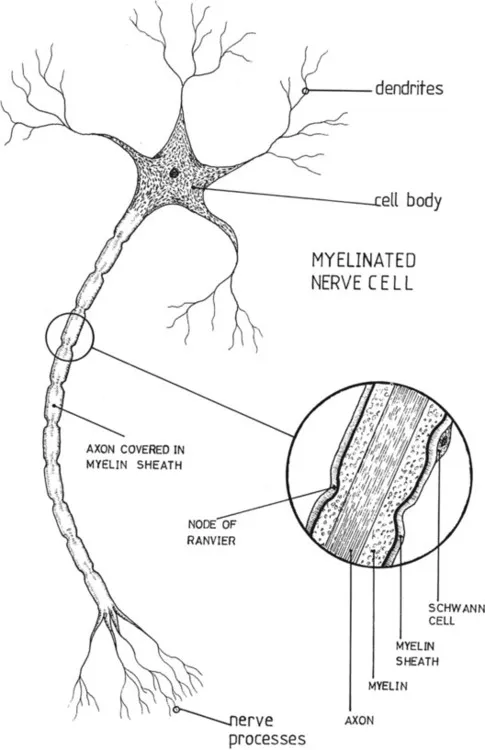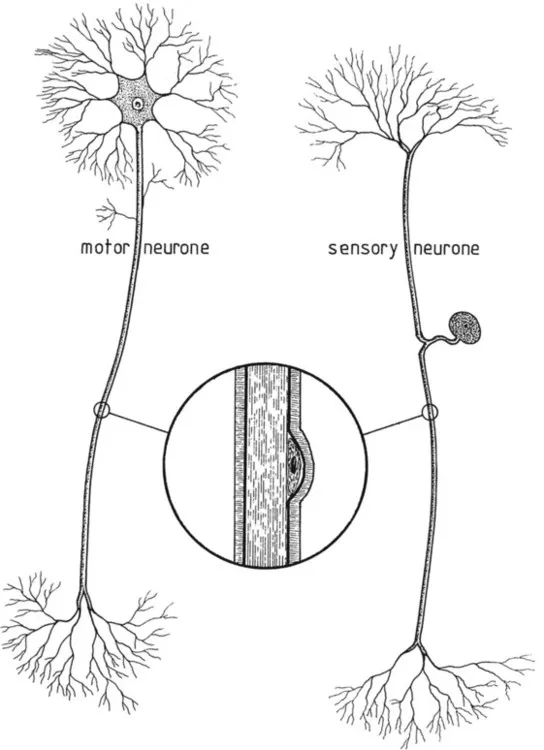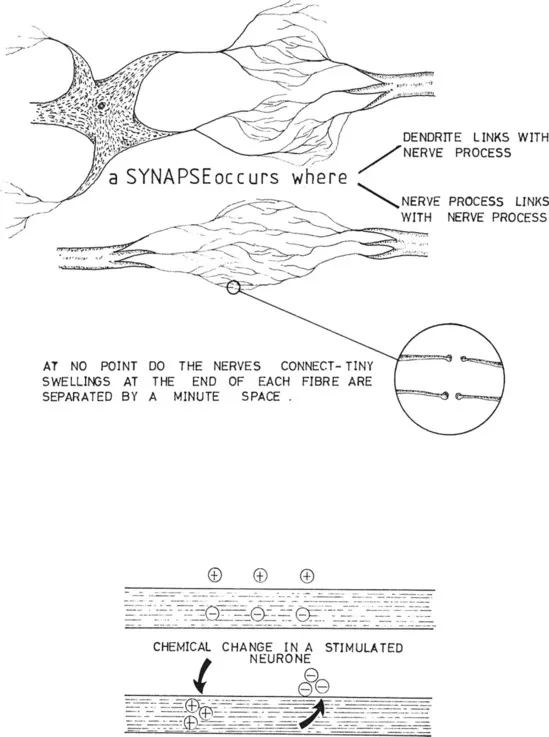![]()
1
The planes of the body
When considering the nervous system anatomically it is necessary to divide the body diagrammatically along different planes in order to look at the various parts from different directions. The following are the different orientations and planes used in this book.
| Anterior (ventral) surface |
- towards or at the front |
| Posterior (dorsal) surface |
- towards or at the back |
| Lateral |
- away from the midline, on the side. |
| Medial |
- towards the midline. |
| Sagittal (median) section |
- dividing the body from top to bottom into a right and left part. |
| Coronal (frontal) section |
- dividing the front from the back, i.e. vertically at right angles to the sagittal section. |
| Transverse |
- dividing the upper part of the body from the lower. A horizontal section through the body. |
![]()
2
The neurone
Publisher Summary
This chapter discusses the structure and functions of neurons. The neuron or nerve cell is the functional unit of the nervous system. It consists of a cell body and a number of nerve fibers. The function of the neuron is to carry information in the form of nerve impulses from one point to another. As with any other cell in the body, cytoplasm forms the major part, with a nucleus at its center. Surrounding the nucleus are the Nissl granules that contain RNA and are thought to produce protein for the cells. The cells come in a variety of shapes and, compared with other cells in the body, are relatively large. The red blood cell is about 7–5 μm in diameter, whereas the neuron may vary from 10–100 μm. The nerve cell body is essential for the life of the nerve and if it is destroyed, it cannot regenerate. Attached to the cell body are the nerve fibers. These are of two types that include (1) the dendrites, which are short, branching fibers receiving information, of which there may be one or more, and (2) the axon, which may be short or more than a meter long and of varying thickness. The axon transmits information away from the nerve cell. It may give off branches along its length, and at its far end has several small branches. Within these nerve endings are vesicles containing chemical transmitter substances, necessary to produce another impulse in the connecting neuron, or to act on the muscle cell.
The neurone or nerve cell is the functional unit of the nervous system. It consists of a cell body and a number of nerve fibres. The function of the neurone is to carry information in the form of nerve impulses from one point to another.
As with any other cell in the body, cytoplasm forms the major part, with a nucleus at its centre. Surroundingthe nucleus are the Nissl granules which contain RNA and are thought to produce protein for the cells. The cells comein a variety of shapes, and compared with other cells in the body are relatively large. For example the red blood cell is about 7·5 microns in diameter whereas the neurone may vary from 10–100 microns. The nerve cell body isessential for the life of the nerve and if it is destroyed it cannot regenerate.
Attached to the cell body are the nerve fibres. These are of two types: the dendrites, which are short, branching fibres receiving information, of which there may be one or more, and the axon which may be short o more than a metre long and of varying thickness. The axon transmits information away from the nerve cell. It may giveoff branches along its length, and at its far end has several small branches. Within these nerve endings are vesiclescontaining chemical transmitter substances, necessary to produce another impulse in the connecting neurone, or to acton the muscle cell.
Those axons found in the peripheral nervous system and in reflex arcs, those connecting the spinal cord and cerebellum, and the motor fibres to the muscles, are all surrounded by a fatty sheath, the myelin sheath, and are therefore called myelinated nerves. This sheath is wound around the axon in a spiral fashion and is much thicker than the axon itself. It acts as an insulator preventing impulses jumping across to the neighbouring nerves. The myelin sheath is interrupted at intervals along its length, allowing the outer membrane, the neurilemma, to dip down and touch the axon. These dips are called the nodes of Ranvier. The neurilemma and Schwann cell are present in non-myelinated neurones as well. They are both necessary for the regeneration of the nerve fibre. Surrounding the whole is connective tissue, which binds the neurones together to form a nerve. Non-myelinated nerves are found in the autonomic nervous system.
The motor neurone has its cell body at one end of the axon. Ittransmits information from the brain and spinal cord to the muscles and glands. Sensory neurones have the cell body to one side, with dendrites and axon coming off a short process. They receive information from receptors and sendit to the spinal cord and brain. Association neurones link one neurone to another. In the nervous system there are also cells which do not receive or transmit information; they are the connective tissue of the nervous system and support, feed and repair the neurones. In the brain and spinal cord they are called neuroglia, and in the peripheral nervous system, the Schwann cells.
The synapse
The nerve endings of the axon, with their vesicles, will connect with the dendrites or cell body of another neurone, or with a muscle cell or gland. The junction of one neurone with another it is called a synapse. Several neurones may be involved in the synapse and any one neurone is likely to link up with many others. Under the electron microscope it can be seen that there is a minute gap between the synaptic knobs of the axon and the dendrites or cell body with which they are linking.
The nerve impulse
As has already been said the function of a neurone is to carry nerve impulses. These have been likened to a ‘wave of negativity’ along the axon of a neurone. Information is picked up by receptor cells. This may be in a chemical form as in the eyes (see p. 63), or a physical form from pressure on the skin or sound waves on the ear drums, or it may start off as an electrical stimulus from another nerve. Sometimes the receptor is part of the neurone, sometimes it links with it. In either case the information is transformed into an electrical impulse, whatever causes the original stimulation.
When a neurone is at rest the cytoplasm in the axon is rich in potassium, but because it also has a large number of protein molecules and some chloride the membrane is negative on the inside. The tissue fluid bathing the outside of the membrane is rich in sodium, with some chloride. It is therefore p...



